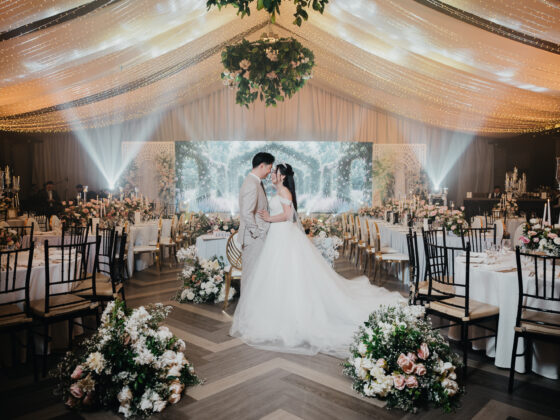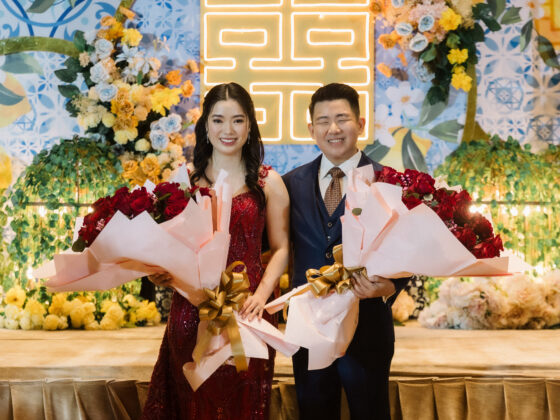The Philippines is composed of beliefs and customs, influenced by its complex history of colonization. With Christianity ingrained in its culture, wedding ceremonies transform into memorable celebrations that not only bind couples in love but also give tribute to their cultural roots.
Each tradition is rich with significance and symbolism, making the union a reflection of their fruitful past. From the garments to the vows, every aspect tells a story of love, faith, and community, crafting a distinct celebration that honors the past while looking forward to a shared future. However, some customs may not be practiced today by modern couples, but these still have a vital role for some people.
WE had the privilege of an exclusive interview with Ms. Rita Neri, founder of Rita Neri Event Planners. With 32 years of expertise, she shared her insights on Filipino wedding customs.
“Nowadays, traditional wedding practices are not closely followed or practiced. Perhaps couples from more traditional families and in the provinces still do but not so for more modern couples,” Ms. Rita shared.
To know more about these meaningful customs, discover some of the wedding traditions that couples might find interesting.
1. Pamamanhikan
In Filipino culture, when a couple is in love and ready to commit, they engage in a beautiful tradition called Pamamanhikan. This heartfelt gesture involves the groom’s family formally asking for the bride’s hand in marriage, symbolizing the union of two families.
Originating from pre-colonial times, the term “Pamamanhikan” comes from “panik,” meaning “to take upstairs,” reflecting the custom of visiting homes with elevated entrances way back then. Here’s how it beautifully happens:
Family Gathering and Gifts
The groom’s family’s visit kicks off Pamamanhikan, bringing both families together over delicious food and thoughtful gifts. Often, the groom’s family will share specialties from their hometown, like Pastillas or Suman, or any special cuisine, symbolizing a warm gesture. This gathering over a shared meal creates a perfect foundation for the celebration ahead.
Building connections
This gathering allows both families to connect and share stories, laughter, and memories. It’s a meaningful first step in the union of two families, building a bond that will grow stronger as the couple embarks on their married life.
Seeking the family’s blessing
At the heart of Pamamanhikan is the groom’s respectful request for the bride’s family’s blessing. This gesture reflects a sincere commitment, not only to each other but to their families, setting a meaningful and respectful tone for their journey together.
Planning the wedding
With blessings received, it’s time to discuss the wedding plans. Families cover key details like the date, location, guest list, and budget. This stage is all about aligning visions and beginning the journey to bring the couple’s dream wedding to life.
Guidance from elders
A Filipino family gathering wouldn’t be complete without advice from elders. Their words of wisdom and encouragement help prepare the couple for married life, honoring tradition, family bonds, and love as they step on this new journey together.
Despite its old-fashioned vibe in today’s casual world, Pamamanhikan remains meaningful, showcasing respect for tradition and family.
2. Sukob: A Bad Luck
In Filipino culture, “Sukob,” which translates to “conflict,” holds significant weight when it comes to wedding planning. The belief is clear: never set your wedding date in the same year as your sibling’s wedding. The idea is that luck gets divided among siblings, affecting the prosperity of marriages. More to that, it’s considered ill-fated to schedule a wedding in the same year that a family member has passed away. This is rooted in the belief that such unfortunate occurrences may bring newlyweds bad luck. Sukob superstition pays respect to familial bonds and the importance of harmony within the family.
For many, following these customs is not just about avoiding bad luck; it’s a way to honor family and ancestors. In today’s fast-paced world, where traditions can sometimes feel overlooked, practices like Sukob remind some couples of the importance of connection, respect, and the sacredness of marriage.
3. Pearls: A sign of tears
I once heard from my college friend, Summer, that wearing pearls is said to bring tears. As someone who feels both beautiful and elegant when wearing this classic accessory, I find it interesting to explore the origins of this belief. While pearls may shimmer with enchantment, there’s a traditional notion that brides should avoid wearing them on their wedding day. According to superstitions and several wedding publications, these lovely gems are seen as “tears of oysters” which might bring tears to the one who wears them.
But when it comes to your special day, whether you choose pearls or diamonds, the real focus should be on the love surrounding you. Embrace the joy of the moment and the connection with your partner as you walk on this beautiful journey.
4. Money Dance
The money dance, also known as “Sabitan ng pera,” is a lively tradition at Filipino weddings that brings couples and their guests together for an unforgettable celebration. This celebration serves as a fun part of the reception, where loved ones come together to express their well-wishes for the couple’s future. As the couple dances, friends and family share their hopes for wealth and abundance, turning the moment into a heartfelt celebration of love and prosperity.
@carlo_abaquita Money Dance in the Philippines #foryou #foryoupage #fyp #fypシ #fypageシ #carloabaquitaweddings #carloabaquita #cebuweddingplanner
♬ Save The Best For Last – Vanessa Williams
During the dance, guests participate by pinning and hanging money on the couple’s wedding attire using pardibles. This playful interaction creates a festive atmosphere and speaks the community’s support for the couple as they walk on this new chapter together. It’s an exciting and unique way to offer practical gifts that will undoubtedly help the newlyweds as they start their lives together. After all, who wouldn’t love a blend of fun and practicality on their wedding day?
5. The 13 Coins or Arras
According to The Knot, Filipinos, Spanish, and Latin Americans practice this tradition. Arras, in Spanish, means “earnest money.” The 13 coins symbolize the groom’s promise to provide for his bride and their family as a sign of trust and love.
As couples commence on the new chapter of their lives, it is important to take note of not just their love and bond, but also their responsibility to each other as they step on a fresh and incredible journey.
Various traditions from diverse cultures hold deep significance, shaping their origins and identities. Regardless of whether you personally believe in or practice these customs, it’s essential to respect and celebrate them according to your personal preferences and beliefs.
“I have a bride who carried her grandmother’s rosary that was blessed by the pope, in her walk down the aisle and will pass this on to her daughter when it’s her turn to be a bride,” Ms. Rita shared.
“My message to all soon to weds is for them to make their own traditions. To feel free to express their love and commitment in whatever manner suits their particular situation. Of course, they may still want to practice some of the more older traditions but this need not inhibit incorporating their very own practices,” Ms. Neri expressed.
Embracing individuality and these traditions enriches our connections and keeps the spirit of our heritage alive, reminding us of the values that have guided those before us. And with that, make your wedding day truly your own, and happy WEdding planning because celebrating love is also an expression of your individuality.
ABOUT THE SOURCE:

Photo by NQ by Metrophoto
Rita Neri, the visionary behind Rita Neri Event Planners, is a pioneer in the Philippine wedding industry. With over 3 decades of experience, she has set the gold standard in event coordination. Known for her timeless elegance and deep respect for Filipino customs, she continues to inspire couples and industry professionals alike.













